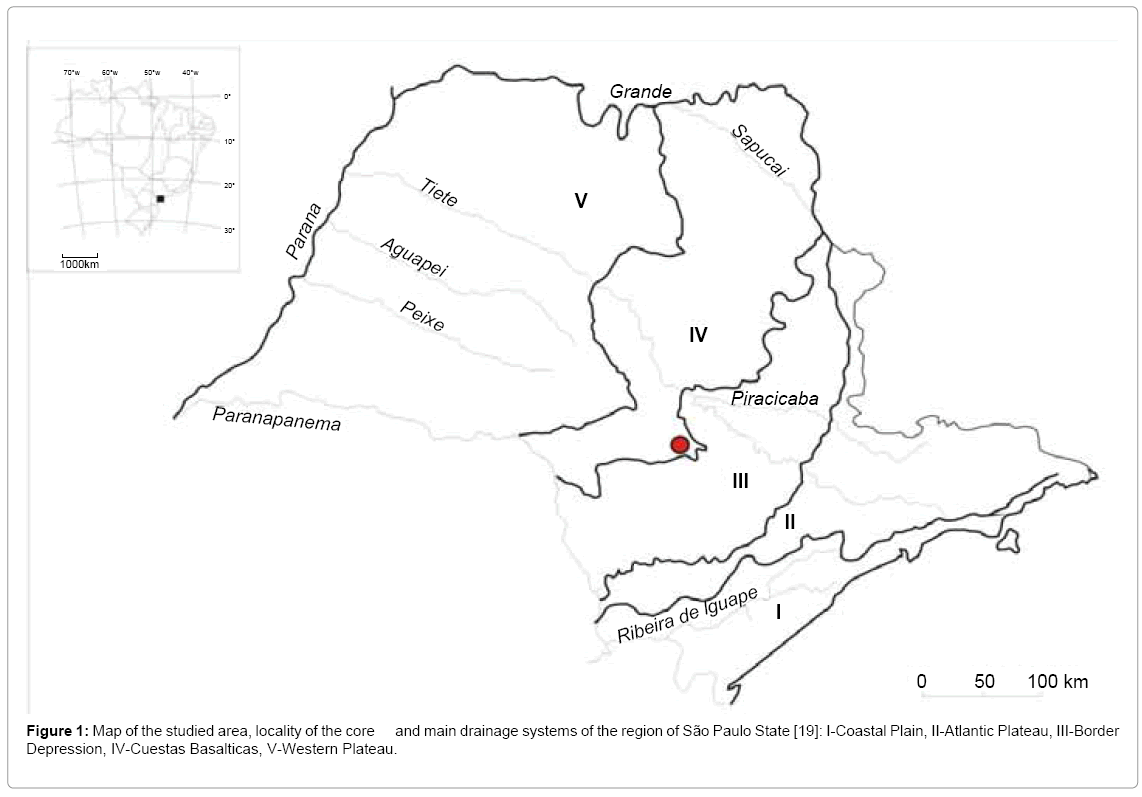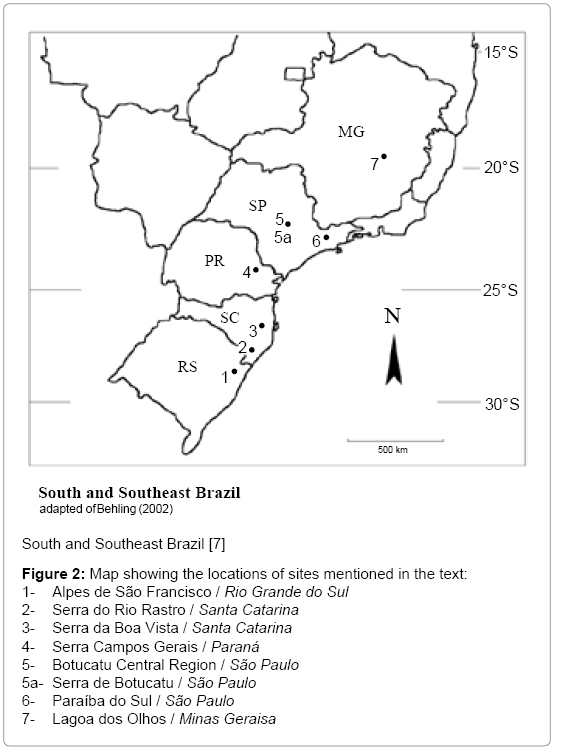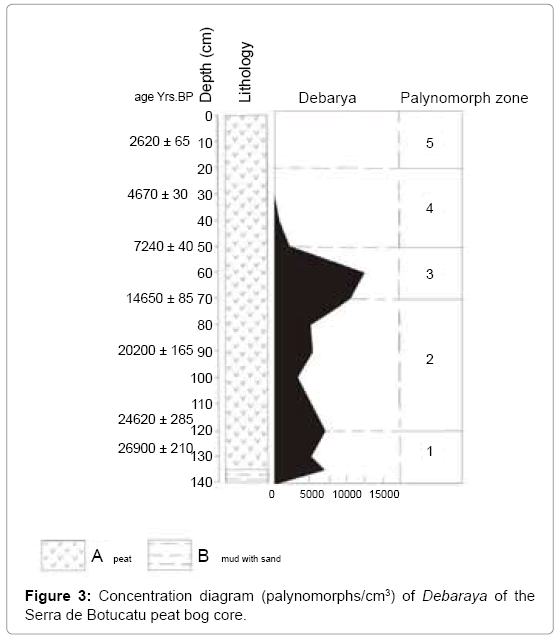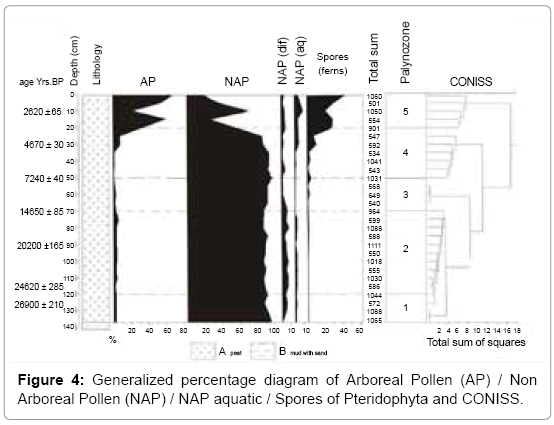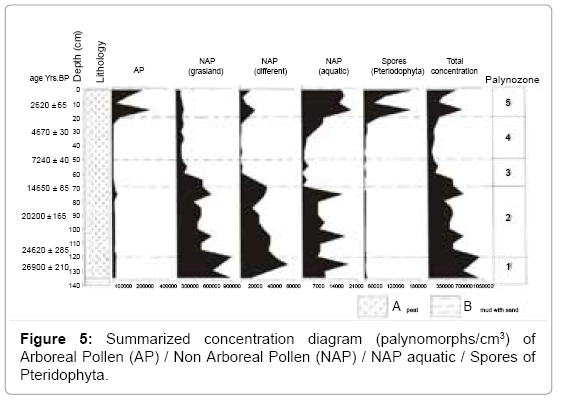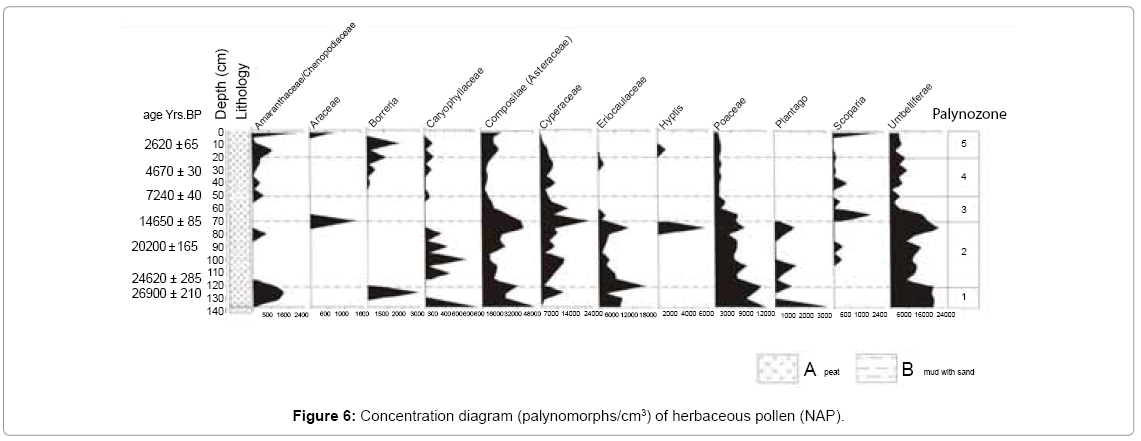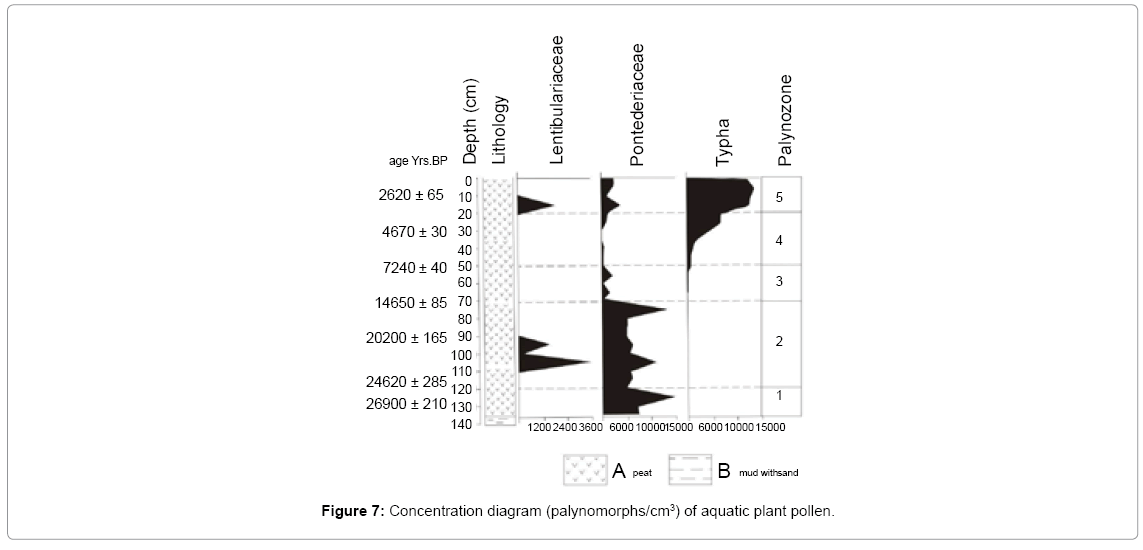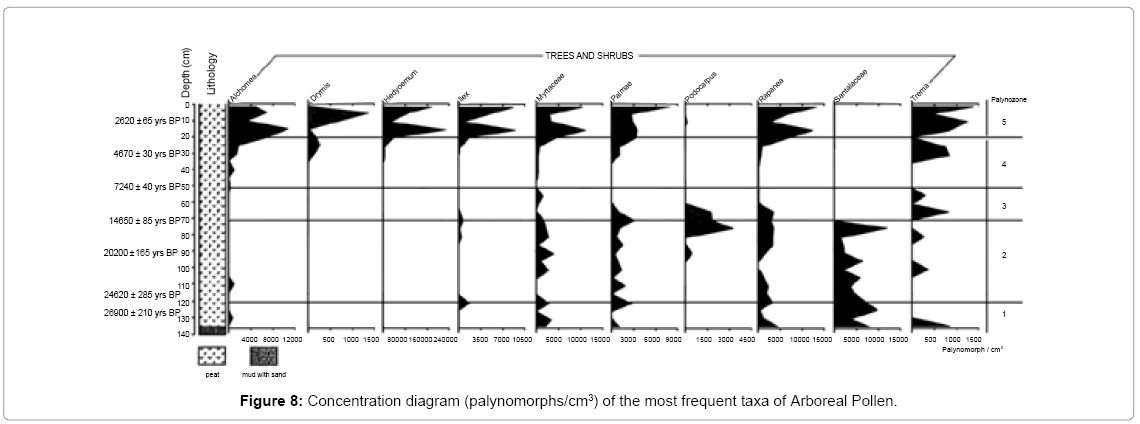Palaeoclimatic and Palaeoenvironmental Changes in the Serra de Botucatu (Southeast Brazil) during the Late Pleistocene and Holocene
Received: 02-Jun-2013 / Accepted Date: 28-Feb-2013 / Published Date: 04-Mar-2013 DOI: 10.4172/2157-7617.1000134
Abstract
We present a temporal resolution in pollen and spore assemblages study, obtained from core sampling at a peat deposit in Serra de Botucatu, located at 900 m altitude in São Paulo State, southeastern Brazilian Plateau. This region was covered by grassland vegetation and forest patches throughout the recorded period. The palynomorphs of Debarya algae, found in some samples, were also used as proxies for palaeoclimatic and palaeoenvironmental reconstructions. The palynological analysis of 27 samples from the Late Pleistocene-Holocene plus 14C dating, allowed the recognition of five distinct climatic and palaeoenvironmental phases (palynozones). Between 28,460-25,700 yrs BP climate was predominantly humid and cold (temperate cold and wet). Among 25,700-14,650 yrs BP climate became dry and less cold (predominantly temperate cold). After that, between 14,650-7240 yrs BP climate was predominantly cold and drier at the beginning of that period, then more humid and changed into dry and warmer at the end of this palynozone (predominantly temperate). Probably, the most humid time for this period was at the beginning of the Holocene. The time interval between 7240-3680 yrs BP was characterized by slightly warmer and more humid (predominantly temperate wet). An increase in temperature and humidity occurred after 3680 yrs BP until present (tropical climate of altitude). A predominantly short period of drier and colder climate was established around 2620 yrs BP. This paper contributes to a better understanding of the climatic oscillations throughout 28 K years, at an ecological tension zone between tropical and subtropical eastern South America continental shelf.
Keywords: Brazil; Palynology; Highlands; Palaeoclimate; Late Quaternary; Grassland; Marsh forest
9503Introduction
Relatively little is known about Late Quaternary vegetation and climatic history for southeastern Brazilian lowland, and a few records are available to provide insight into climate dynamics. The climatic changes that occurred during the transition between the Pleistocene and Holocene have been the main factors influencing peat deposition in many regions of the world [1]. Pollen grains and spores of vascular plants present in such deposits provide important information about palaeoclimates [2,3].
In Brazil, the more informative and rich palynological materials for palaeoclimatic reconstructions have been obtained from Pleistocene and Holocene transition peat bogs [4-12] and has led to the validation of new palaeoenvironmental proxies. According to these authors, south and southeast Brazil appears to have been dry at the Late Pleistocene or beginning of the Holocene, depending on the latitude. Between 12,000 and 8,000 yr BP, the climate was characterized by high effective rainfall interrupted by some short dry episodes. After 8,000 yr BP humid climatic conditions were recorded all over the studied areas, including studies of diatoms in Lagoa Dourada (south Brazil) and forests started to expand [13,14].
The application of carbon isotopes in studies of SOM (soil organic matter) dynamics has been also applied to infer information about vegetation and climate changes during the Late Pleistocene and Holocene. This approach has been used in different areas in southeast Brazil (Botucatu, Anhembi, Piracicaba and Jaguariúna, São Paulo, State) demonstrating significant climatic oscillations on vegetation composition [15].
In comparing the results the four sites above mentioned, it was observed that the high frequency and intensity of paleofires, supporting the existence of a drier climate occurred between 9000-3000 yr. BP [15,16].
Pessenda et al. [17] studied the evolution of a tropical rainforest based in studies of carbon isotopes and pollen records of the region of Curucutu located in southern coastal zone of São Paulo State (Brazil), at an altitude ranging from 750-850 m. The results indicate that between 21,000-16,000 yr. BP a probable forest expansion that could be associated with a humid period and between 16,000-5700 yr. BP the opening of the forest vegetation and perhaps associated with a drier period. After 5700 to 4500 yr. BP forest expansion and more humid climate has occurred.
For the State of São Paulo, just a few records about palaeoclimate oscillations from 30,000 years BP until present are available for the Occidental Plateau region. Palynological records from peat bogs in Jacareí and Taubaté located at the Paraiba do Sul River valley, northeastern portion of the state, have been studied by Garcia et al. [9]. The extensive peat formation of Jacarei, limited by the Mantiqueira Mountain Range, began to be deposited around 9720-8850 years BP, practically at the same time of the deposits at Taubaté (9700- 8200 years BP). Palynological data indicate that at the beginning of peat accumulation the climate was colder than the present, as well as predominantly humid, as vast swamps were spread all over that region. According to Garcia (1994) and De Oliveira et al. [4,18] pollen of Araucaria found in this region may be evidence of more humid conditions at the beginning of the Holocene.
This paper reports the palynological results obtained from a peat core sampled at the Serra de Botucatu region, São Paulo State, providing for a better control over climatic oscillations that occurred in this area during the Late Pleistocene and Holocene. The primary objective of this study was to reconstruct the paleovegetation and paleoclimatic history during the 28 K years from Serra de Botucatu peat bog and to correlate it with other palynological records from south and southeast Brazil.
Study area
The study area is located at the Pardo river basin, Bofete County, São Paulo State (23°00´43´´S, 48°22´40´´W). The altitude is around 900 meters, between the Occidental Plateau and Border Depression (Figures 1 and 2). According to Almeida [19], this area belongs to a geomorphological unit called as “cuestas basálticas” (basaltic escarpments), locally named Serra de Botucatu. According to Orlando Villas (oral communications) Botucatu means “good air” from indigenous Tupi language. Indeed, at a local scale, this area is transitional between the higher escarpments of Occidental Plateau and the lower depressed zone to the east. The Occidental Plateau geological substrate has Cretaceous sandstone overlapping Jurassic basaltic rocks. Moreover, at a larger scale, the region is transitional between the Brazilian Central Plateau, with warmer continental tropical climate, and the Southern Plateau which is dominated by subtropical influence with cold winds and other aspect. This is why the study of environmental changes in this area is meaningful to the understanding of climate changing in a continental wider scope.
Figure 1: Map of the studied area, locality of the core and main drainage systems of the region of São Paulo State [19]: I-Coastal Plain, II-Atlantic Plateau, III-Border Depression, IV-Cuestas Basalticas, V-Western Plateau.
Figure 2:Map showing the locations of sites mentioned in the text:
1- Alpes de São Francisco/Rio Grande do Sul
2- Serra do Rio Rastro/Santa Catarina
3- Serra da Boa Vista/Santa Catarina
4- Serra Campos Gerais/Paraná
5- Botucatu Central Region/São Paulo
5a- Serra de Botucatu/São Paulo
6- Paraíba do Sul/São Paulo
7- Lagoa dos Olhos/Minas Geraisa
Actually, the Botucatu region is characterized by a subtropical to tropical of altitude climate, seasonally alternating dry and humid periods, humidity being controlled by tropical and polar masses [20]. According to Köppen classification system [21], most of the region is characterized by humid and warm climate (Cwa), and the average annual precipitation is 1300 mm and the annual mean temperature ranges from 19 to 20° C. Both savanna (cerrado) and seasonal semideciduous forests are found in the area [22,23]. The savanna covers the smooth relief below the cuestas zone to the east, with dystrophic soils and low water retention. Forests are found on steeper relief, along valleys with eutrophic soils and good water retention. Therefore, there is a complex cerrado-forest mosaic in the region, following the predominant local climate, relief and soil type [24]. In the last years, native vegetation is being devastated very fast, with the spread of agricultural fields and pastures.
The sampling site is covered by a marsh forest with predominance of hydrophylous shrubs and trees such as Alchornea, Tapirira, Drymis, Hedyosmum and Rapanea. These plants are pioneer species growing up in small depressions along flood plains, where excessive humidity is common. Species of Poaceae, Cyperaceae and Typhaceae are predominant, although Onagraceae, Pontederiaceae, Umbelliferae and Melastomataceae families are also found [25].
The first geological investigations in this region began at the end of the XIXth century, focusing on the outcrops of sandstone impregnated by oil [26]. The quaternary sediments were studied by Behling et al. [5] in the central region of Botucatu County, a little more to the west in relationship with our research area. The authors describe palaeoenvironment changes connected to climatic changes between 30,000 and 18,000 years BP, corresponding to the Last Glacial period when the climate was dry and predominantly cold and scarce grassland vegetation and Araucaria forests (limited to mosaic features) were present.
Materials and Methods
A core was drilled in the flood plain of a peat bog using a vibracore according to the methodology proposed by Finkl and Khalil [27]. The depth of the sediments cored was 140 cm, including 135 cm of peat layer under a light sand mud (without pollen) with sand 5 cm thick. The sampling for palynological analysis was done in of 5 cm intervals.
Chemical treatment of the 2 cm3 samples was done according to the methodology elaborated by Ybert et al. [28]. It includes: (1) using HCl (10%) for carbonate elimination and posterior washing; (2) KOH (10%) boiling for humic acid elimination and better dispersion of sediments and organic matter, and posterior washing by distilled water; (3) Acetolysis; (4) Dissolution (elimination) of siliceous minerals with HF (40%) following Faegri and Iversen [29]. Permanent slides were mounted in glycerin in the laboratory of Geosciences Institute of the University of São Paulo.
Identification of pollen grains and spores of vascular plants was done using a reference collection of extant palynomorphs, actually occuring in the region and adjacent areas. Besides, some publications were used as reference [30-35]. Definition of algae palynomorph Debarya was done according to van Geel and van der Hammen [36].
Palynological diagrams for percentage and concentration calculations of the taxa were done using Tilia and Tilia Graph software and zonation of the pollen record is based on changes in the pollen assemblages and cluster analysis for stratigraphically constrained samples using the CONISS software [37]. The ages for each pollen zone have been interpolated from the available 14C dates (Table 1), through the Program Microsoft Excel in the Trendline function with Linear Interpolation. Four tablets of Lycopodium clavatum, each one containing 12,100 spores were added to each sample before chemical treatment, for calculating the overall pollen concentration per volume of sediment (cm3) [38]. At least 500 pollen grains per sample besides pteridophyte spores and Debarya algae were counted. Palaeoenvironmental interpretation was based on all regional and local taxa, the percentage of each taxa was calculated using the total pollen sum of the respective vegetation group.
| Depth (cm) | Age Model Interpolated Age (yrs BP) | (Rounded up) |
|---|---|---|
| 5 | 1953,3 | 1960 |
| 15 | 3103,3 | 3110 |
| 20 | 3678,3 | 3680 |
| 25 | 4253,3 | 4260 |
| 35 | 5403,3 | 5410 |
| 40 | 5978,3 | 5980 |
| 45 | 6553,3 | 6560 |
| 55 | 9170 | 9170 |
| 60 | 10790 | 10790 |
| 65 | 12410 | 12410 |
| 75 | 15650 | 15650 |
| 80 | 17270 | 17270 |
| 85 | 18890 | 18890 |
| 95 | 21077,9 | 21080 |
| 100 | 22000,5 | 22010 |
| 105 | 22923,1 | 22930 |
| 110 | 23845,7 | 23850 |
| 120 | 25690,9 | 25700 |
| 130 | 27536,1 | 27540 |
| 135 | 28458,7 | 28460 |
| 140 | 29381,3 | 29390 |
Table 1: Linear interpolated ages in different depth intervals from the uncalibrated radiocarbon ages (14C yr BP).
Seven radiometric 14C dating were obtained from the total organic matter and produced by Leibniz Laboratory (Christian-Albrechts Universitat, Kiel, Germany). One sample was dated at Beta Analytics (Miami, Florida, USA). All standard and calibrated ages can be seen on Table 2.
| Laboratory number | |||||
|---|---|---|---|---|---|
| Depth (cm) | Leibniz Labor | Beta Analytic | Dating by 14C (yrs BP) | Cal age (yrs from to BC/AD) | |
| 10 | KI- 5098,01 | 2620 ± 65 | 545-905 | ||
| 30 | KI- 5098,02 | 4670 ± 30 | 3355-3625 | ||
| 50 | KI- 5098,03 | 7240 ± 40 | 6005-6225 | ||
| 70 | KI- 5098,04 | 14650 ± 85 | 15050-16250 | ||
| 90 | KI- 5098,05 | 20200 ± 165 | <21050 | ||
| 115 | KI- 5098,06 | 24620 ± 285 | <22050 | ||
| 126 | Beta - 178129 | 26900 ± 210 | |||
Table 2: Absolute age by 14C dating of the samples from the peatbog core of the Serra de Botucatú executed in Leibniz Labor and Beta Analytic Laboratories.
Results
The results obtained on concentration of palynomorph of Debarya algae are represented in (Figure 3), AP (arboreal pollen), NAP (non arboreal pollen) and aquatic/spores are presented in percentage palynodiagram (Figure 4) as well as in a concentration palynodiagram (Figure 5) and concentration palynodiagram of herbaceous pollen is displayed on Figure 6. Concentration palynodiagram of pollen from aquatic plants is represented in Figure 7. Concentration diagram of the most frequent arboreal pollen is displayed in the Figure 8.
Taxonomic variety of arboreal pollen and their presence-absence from the samples are shown in Table 3. In some samples the NAP represent more than 80% of the total sum of vascular plants. Five different pollen zones were identified in palynological diagrams and used in the palaeoclimatic inferences.
| Arboreal pollen (AP) | Palynozone (stage) | |||||||
|---|---|---|---|---|---|---|---|---|
| 1 | 2 | 3 | 4 | 5 | ||||
| Alchornea | - | - | - | + | + | |||
| Alnus | - | + | + | - | - | |||
| Anacardiaceae | - | + | - | + | + | |||
| Annonaceae | - | - | - | - | + | |||
| Araliaceae | - | - | - | + | + | |||
| Caryocar | - | - | + | + | - | |||
| Drymis | - | - | - | + | + | |||
| Flacourtiaceae | - | + | - | + | + | |||
| Hedyosmum | - | - | - | + | + | |||
| Ilex | + | - | - | + | + | |||
| Laplacea | - | - | - | + | + | |||
| Mimosaceae | + | + | + | - | - | |||
| Myrtaceae | + | + | + | + | + | |||
| Palmae | - | - | + | + | + | |||
| Podocarpus | - | + | + | - | + | |||
| Rapanea | + | + | + | + | + | |||
| Santalaceae | + | + | - | - | - | |||
| Sapotaceae | + | - | - | - | + | |||
| Trema | - | - | - | + | + | |||
| Total sum of taxa | 6 | 8 | 7 | 13 | 15 | |||
Table 3: Arboreal pollen (AP) records from the palynozones 1-5: (+) presence, (-) absence.
Table 4 presents the sedimentation rate in different depth intervals inferred from the uncalibrated radiocarbon ages. In general the sedimentation rates were similar during the periods of 28,460 to 14,650 yr. BP. The sedimentation rate increased between 7240-2620 yr. BP.
| Interval (cm) | Sedimentation Rates (cm yr)/Age Intervals (yr BP) |
|---|---|
| 10-30 | 0.0098/(2620-4670) |
| 30-50 | 0.0078/(4670-7240) |
| 50-70 | 0.0027/(7240-14,65) |
| 70-90 | 0.0036/(14,650-20,200) |
| 90-120 | 0.0055/(20,200-25,700) |
| 120-135 | 0.0054/(25,700-28,460) |
Table 4: Sedimentation rates for the sediment interval.
Palynozone 1: 135-120 cm (>28,460-25,700 yrs BP). This phase is characterized by a predominance of grassland vegetation (NAP = 90%, Figure 4). The beginning of this palynozone is marked by a significant concentration of Pontederiaceae pollens grains (10,000- 15,000 grains cm3) related to marsh environments (Figure 7), as well as high concentration of species related to grassland vegetation (800,000 grains cm3, Figure 5). Grasslands predominated in same levels where xerophylous and mesophylous species of Asteraceae (5%), Borreria (1%), Chenopodiaceae-Amaranthaceae (1%), and Poaceae - 90% - Figure 6) occupied most part of the region. Scarce records of arboreal pollen percentage of Ilex (1%), Mimosa (1%), Myrtaceae (1%), Rapanea (0,5% - not shown in diagrams) represent evidence of extremely limited forested areas. During this period there is the formation of a small deposition basin indicated by the presence of Pontederiaceae (frequent in edges of lagoon -Lorenzi, 1991, Figure 7) and Debarya (Figure 3).
Palynozone 2: 120-70 cm (25,700-14,650 yrs BP). This interval is characterized by the abundance of grassland elements (NAP) in high concentrations (500,000 grains cm3, Figure 5). Compositae (Asteraceae) taxa show slight increase starting around 95 cm (21,080 yrs BP -interpolated age) until the end of this palynozone (Figure 6). The small deposition basin still remains with the emergence of other aquatic taxa (Lentibulariaceae, Figure 7). Decrease in concentration of Debarya taxa (5000 grains cm3, Figure 3) and the spores of pteridophyte (8000 grains cm3, Figure 5) in the lower part of this zone may be evidence of a less cold period. Grasslands formed predominantly by species Asteraceae (7%), Cyperaceae (2%), Poaceae (85%) and Umbelliferae (4%-not shown in diagrams) were wide spread. Pollen grains of arboreal vegetation were scarce (3%, Figure 4; 14,000 grains cm3, Figure 5) and limited in composition to a few taxa.
Palynozone 3: 70-50 cm (14,650-7240 yrs BP). Increase concentration of the algae palynomorph Debarya (12,000 grains cm3, Figure 3) and slight increase the taxa of Palmae (1,5%), Mimosa (2%) and Rapanea (2%) may be an evidence of cold and more humid climate conditions. The high concentration of Debarya algae at the beginning of this palynozone may indicate a reflection of flooding areas or a more humid climate.
The Figure 4 shows high percentage (90%) of grasslands (NAP), indicating a spread out of that kind of vegetation during this time, even if the diagram representing the summaried pollen concentration (Figure 5) shows otherwise, pointing to a small amount of grasslands along the same period (150,000 grains cm3). Isolated analysis of the percentage diagram might induce misinterpretations, since the curves may be distorted due to the overrepresentation -what seems to be the case. Such pronounced retraction of the vegetation in this period may be connected to the transition between Pleistocene and Holocene.
Palynozone 4: 50-20 cm (7240-3680 yrs BP). The period up to 4670 yrs. BP is characterized by the decrease of the pollinic concentration of the pollen grains from arboreal taxa (12,000 grains cm3, Figure 5), grassland vegetation (80,000 grains cm3, Figure 5) and pteridophyte spores (8000 grains cm3, Figure 5). This episode probably suggests that during this period the forest and grassland vegetation (campos) have both retracted. The spores are represented by Hymenophyllum, Lycopodiaceae, Polypodiaceae, besides other spores of monolete and trilete types. Grassland vegetation percentage predominates in the same levels where xerophylous and mesophylous species of Amaranthaceae-Chenopodiaceae (2%), Asteraceae (6%), Cyperacae (7%), Poaceae (85%) and Umbelliferae (8% - not shown in diagrams) were common. The NAP/aquatic (8000 grains cm3, Figure 5) increased significantly at the end of this palynozone. The marked reduction of the Debarya algae (2000 cm3, Figure 3) points to a less cold climate, with periods of humidity at the end of this palynozone, indicated also by a slight increase of pteridophyte spores (15-20%, Figure 4; 5000 grains cm3, Figure 5). The diversity of trees and shrubs increased in this palynozone (Table 3) (Figure 8).
Palynozone 5: 20-0 cm (3680 yrs BP to present). This interval is characterized by the notable growth of forested areas and diversity of arboreal species (Figure 8) (Table 3), Alchornea (5%), Anacardiaceae (4%), Araliaceae (2%), Flacourtiaceae (3%), Hedyosmum (40%), Ilex (3%), Myrtaceae (4%), Palmae (3%), Sapotaceae (0,5%), and Trema (2% - not shown in diagrams). Abundance of Lentibulariaceae, Pontederiaceae and Typha (frequent in marshy environment- Neves and Lorscheitter [39]) have increased (Figure 7), due probably to an increase in soil humidity and higher temperatures. The forest seems to reestablish with a slight decrease in concentrations of grassland pollens (80,000 grains cm3, Figure 5), and an significant increase of aquatic plants (Figure 7), spores of pteridophyte (150,000 grains cm3, Figure 5) and forest taxa (150,000 grains cm3, Figure 5). In this stage the small deposition basin has turned into a marsh (peat bog), with forests patches. The vegetation is composed of forest patches and grassland vegetation (campos).
Discussion and Regional Correlation
The changes in the Glacial and Holocene periods presented here permit a regional correlation. They agree with the records obtained from several others brazilian sites (Serra de Campos Gerais, Lagoa dos Olhos, Alpes de São Francisco and Paraíba do Sul valley), with similarities in elevation and vegetation type (semi-deciduous forest and grassland vegetation) (Figure 2) [9,18,40]. These records enclose areas of grassland (campos) and forests reflecting colder, dry and warm climatic conditions in south and southeast Brazil during the mentioned periods.
Pre-Last Glacial - Late Glacial period (palinozones 1 and 2: >28,460 (interpolated age -14,650 yrs BP)
The pollen data indicates dominance of the diverse grassland vegetation represented by herbaceous types between >28,460-25,700 yrs BP. The expressive concentration of Debarya algae [36] (Figure 3) and Pontederiaceae (taxa colonizing areas with high humidity - (Figure 7) [41] indicate cold and predominantly humid conditions (temperate climate cold and wet) than the present. The increase in pollen concentration of Eriocaulaceae and Umbelliferae between >28,460 to 25,700 yr. BP -interpolated age), also indicate humid conditions (Figure 6) [39]. In the following period (25,700 -20,200 yrs. BP) the climate became drier and less cold (predominantly temperate cold) than nowadays (also indicated by lower sedimentation rate - 0.0055 cm/yr – (Table 4) [17], probably causing the decreased concentration of Debarya (Figure 3 - algae taxa associated only to cold mountain climates [32], and Umbelliferae (Figure 6), as well as the appearance of Santalaceae taxa (savanna vegetation – (Table 3) (Figure 8) and increase of the Caryophyllaceae taxa (which is indicative of drier conditions – (Figure 6) [42].
According to Behling [5] cold climates during Glacial times have been thought to relate to increased frequency and intensity of Antarctic cold front winds in southeastern Brazil. Abundant grassland vegetation pollen throughout the palynological record indicates that the Serra de Botucatu region has been covered by grassland vegetation since the Pre-Last Glacial period, dominated by Poaceae (Figure 6). Behling [43] has demonstrated that expansion of grassland vegetation can be interpreted as a consequence of lower annual precipitation and a longer dry season.
Furthermore, two palynological records from southern Brazil, the Serra de Campos Gerais and Alpes de São Francisco, both dated between 25,000-13,000 cal yrs BP, support the idea of cold and dry climate with predominance of grassland. Our data do not correspond entirely to the record observed at these two localities above mentioned, as the climate in the Serra de Botucatu became colder and more humid than today (temperate cold and wet) between the period of 20,200 to 14,650 yrs. BP, indicated by the appearance of Podocarpus (palynozone 2, (Figure 8 and Table 3), increase of the Debarya concentration (Figure 3), Pontederiaceae (taxa colonizing of areas with high humidity-Figure 7) and decrease of the Caryophyllaceae pollen concentration (Figure 6).
At Lagoa dos Olhos (southeast Brazil) a cooling indicated by presence of Podocarpus took place from 19,950 to 13,685 yrs BP, when conditions were predominantly humid, with the presence of a swamp [18]. This data is fully consistent with the record ranging from 20,200 to 14,650 yrs BP at Serra de Botucatu region, where the predominance of a colder and more humid climate (temperate cold and wet) is also indicated by the presence of Podocarpus).
Late Glacial and mid-Holocene (Palynozones 3 and 4): 14,650 - 3680 yrs BP -interpolated age)
The pollen record for this period documents a significant increase in concentration of the algae palynomorph Debarya (Figure 3), decrease of Asteraceae (campos) and slight increase of Cyperaceae (taxa colonizing of humid areas, [39] at the beginning of this palynozone (14,650-10,790 yrs. BP interpolated age), that may be evidence of colder and more humid climate conditions (similar to the prior period). The lower concentration taxa of grassland vegetation (Araceae, Compositae (Asteraceae), Caryophyllaceae, Eriocaulaceae, Scoparia, Plantago, Umbelliferae and aquatic plant pollen (Pontederiaceae and Typha - (Figure 6 and 7), and the decrease of the Debarya algae (Figure 3), document a change to a less cold and drier climate (predominantly temperate cold) between 10,790-7240 yrs. BP than at present - also demonstrated by low sedimentation rate - 0.0027 cm/yr – (Table 4) [17].
In the southern and southeastern Brazil the climate during the transition between late Glacial and early Holocene was cold and dry with a pronounced dry season. These conditions can be explained by a stronger influence of dry tropical continental air masses that would have blocked polar cold fronts [22]. These climate conditions probably did not favor the expansion of Araucaria forest taxa in the Serra de Botucatu region and other sites during this period [1,43,44].
A cooler and more humid climate than today has been documented around 9800 yrs BP, at middle reaches of Paraíba do Sul valley (southeast Brazil) with scarce arboreal vegetation [9]. These results are approximately consistent with our palynozone 3 (around 10,790 yrs. BP interpolated age) where scarce arboreal vegetation and a cold period are also present (Figure 8 and Table 3), were indicated by reappearance of Podocarpus (Figure 8), decrease of Asteraceae, Poaceae and Scoparia and increase of Cyperaceae (Figure 6). Climate conditions between 8240 to 5400 yrs BP (warm and still humid) in that same valley, correspond approximately to the record observed at the Serra de Botucatu, where climate was slightly warmer and more humid (predominantly temperate wet) for the period between 7240 to 3680 yrs BP., thus causing the decrease of Debarya algae (Figure 3), Asteraceae and Poaceae (Figure 6), and increase of concentration the Typha taxa (colonizing of areas with high humidity and warmer climate - Figure 7, [41]. A highest sedimentation rate of 0.0078 cm/yr (Table 4) between 7240-4670 yr BP is recorded and reinforces the climatic interpretation of pollen analysis for this palynozone, suggesting a more humid environment [17].
The climate conditions recorded in the area of Lagoa dos Olhos (southeast Brazil), for the period between 6790-4000 yrs BP, is in agreement with the palynozone 4 (7240 to 3680 yrs BP - interpolated age) at Serra de Botucatu site, when arboreal elements (Figure 8 and Table 3) predominated in both areas, and the climate was somewhat slightly warmer and more humid than the present (with periods of increased humidity) at the end of this period.
Behling [43] describing the Serra da Boa Vista palynological records (southeastern Brazil), indicates a warm and drier climate than the present between 10,000-2900 yrs. BP, and an expansion of the Atlantic Pluvial Forest between 7800-3200 yrs. BP that must be interpreted as an increase in humidity. The same author also recognizes a decrease of the Poaceae taxa and an increase of Atlantic Pluvial Forest elements in the Serra do Rio do Rastro (southern Brazil) around 7400 yrs. BP. Nevertheless, in the area of Serra de Botucatu it was recorded a cold and more humid climate about 10,790 yrs. BP - interpolated age (palynozone 3) and also recognized a decrease of Poaceae pollen (Figure 7) in the same palynozone, although with decreasing presence of arboreal taxa (Figure 8 and Table 3). In view of these facts the period between 10,000-3000 yrs. BP suggests a re-evaluation of the results for the area of Serra do Rio do Rastro and Serra da Boa Vista sites [8], in relation to the increase of temperature and moisture during the beginning of the Holocene in south and southeast of Brazil. More information and new data at additional sites, including palynological concentration diagrams are necessary to explain this occurrence.
.
Late Holocene (palinozone 5: 3680 yrs BP -to present)
This palynozone, characterized by humidity increase and high temperatures, seems to promote a great expansion of forest and increase in diversity of arboreal taxa. A brief period of drier conditions (2620 to 1960 yr. BP - interpolated age) caused reduction or absence of herbaceous pollen concentration in Amaranthaceae-Chenopodiaceae, Araceae, Asteraceae, Borreria, Cyperaceae, Caryophyllaceae, Eriocaulaceae, Hyptis, Plantago and Scoparia (characteristic taxa of humid environment - Figure 6), as well as a decrease of arboreal pollen concentration, NAP (non arboreal pollen) and spores of pteridophyta around 2620 yr. BP (Figures 5 and 8).
The climate in the Serra da Boa Vista (southern Brazil), between 2900 to 1000 yrs BP, was colder and more humid than the present, with grassland vegetation predominance, which has retracted only at ca.1000 yrs BP when the Araucaria forest expansion and a cold and very humid climate predominance were recorded [43]. This cold and more humid climate of the Serra da Boa Vista does not fit completely with the results of the pollen profile from Serra de Botucatu, which shows a hot and humid climate (similar than the nowadays) with a brief cooler period (3110 yrs. BP - interpolated age) as evidenced by the increase of arboreal pollen percentage (60% - Figure 4) and arboreal pollen concentration (200.000 grains/cm3 -Figure 5), pteridophyta spores (150,000 grains/ cm3 - Figure 5), aquatic plant pollen (Figure 7) and reappearance of montane elements Drymis, Ilex and Podocarpus (Figure 8 and Table 3). The record from Paraíba do Sul valley shows, between 3500-1950 yrs. BP the reappearance of Araucaria and Podocarpus, suggesting also a cooler climate [9].
In the Serra de Botucatu region the increase of arboreal plants (Figures 5 and 8 and Table 3), corresponding to a growth of forest areas, was continuous and more evident around 3680 yrs BP (interpolated age). Forested areas have continued their expansion due to significant climate change (more humidity and higher temperatures) between 3680 yrs BP until nowadays. A highest sedimentation rate (0.0098 cm/yr. - Table 4) is recorded; this is probably associated with a more humid period [17] and thus reinforces the climatic interpretation this palynozone. In this stage a capping process started forming a small deposition basin over the peat bog surrounded by forest patches. The total absence of Debarya algae (Figure 3) is possibly a consequence of a warmer climate and the expansion of the peat bog area, suggesting a tropical climate of altitude.
Conclusions
Palynological results from Serra de Botucatu region, obtained by peat core sampling, allowed inferences on palaeoclimatic changes occurring in this region during the last 28,000 years. Open landscapes represented by grasslands spreading out between 28,460-7240 yrs BP. At the same time forest areas of low diversity were scarce and the climate conditions in general were colder and predominantly drier than today. Temperature was in elevation and more humid conditions than nowadays happened between 7240-3680 yrs BP. The climate became wetter and warmer than the present since 3680 yrs BP. Forests expanded and grasslands vegetation was reduced in the area. Seasonal semi-deciduous forests that cover the studied area nowadays have a relatively short history in development caused by climatic changes.
The presence of Debarya in the record reinforces its reliability as taxa that probably indicate a colder climate of highlands. This approach seems to be a useful tool in palaeoenvironmental research, considerably improving the climatic inferences for that transitional region in Serra de Botucatu, although more studies should be conducted before assuming Debarya as a proxies for paleotemperature.
The absence of Araucaria pollen in study area indicates that this event does not occur in isolation and probably should be interpreted as a regional phenomenon connected with seasonal periods of drought [45], more clearly expressed in highlands regions (covered by grassland vegetation) that was observed in southern and southern-eastern part of Brazil during the Glacial period until the mid-Holocene. This is particularly stressed locally by the relief of the sampling area (cliff border). Besides, Araucaria growing in the past was connected with predominantly cold and humid climate, well illuminated conditions and fertile soils. The cliff border of the Botucatu escarpment were drier than in the lower and less exposed zones of the neighboring landscapes, much more suitable for the Araucaria.
The results of Serra de Botucatu region are in agreement with other palynological results on palaeoclimatic reconstructions for the Glacial period and the Holocene for the São Paulo State, South and Southeast Brazilian regions. The new data presented here show a variety of climatic oscillations and a diversity of landscapes that provide a significant contribution to understanding the environmental changes in the important marsh forest in this region.
Acknowledgements
This study was developed in fulfillment of the PhD. thesis of Walter M. Bissa, supported by FAPESP. We are grateful to Dra. Célia Gouveia and Tiago Attorre for their careful English revision of the manuscript, and Karen C. Silva and Denise Dal Pino for figures diagramming. The authors are deeply thankful to Drs. Mauro de Toledo and Paulo De Blasis for their constructive comments and suggestions, which improved the text significantly. Walter M. Bissa is also in debt to Dra. Ortrud Monika Barth and Dra. Márcia Barros for the training period in the Laboratory of Palynology of the University Federal of the Rio de Janeiro, Brazil. We also thank the Laboratory of Paleobiological Studies of Institute of Geosciences (University of São Paulo).
References
- Behling H, Lichte M (1997) Evidence of dry and cold climatic conditions at glacial times in tropical Southeastern Brazil. Quaternary Research 48: 348-358.
- Webb III T (1991). The spectrum of temporal climatic variability: current estimates and the need for global and regional time series. In: Global Changes of the Past. Boulder University Corporation for Atmospheric Research 61-82.
- Bradley RS (1999) Paleoclimatology. Reconstructing Climates of the Quaternary. (2ndedn) Institute Geophysics series, Elsevier Academic Press, Amsterdam, The Netherlands.
- Garcia MJ (1994) Palynology of Quaternary peat bog river valey ParaÃba do Sul, Etate of São Paulo. PhD thesis, IG/USP, 354.
- Behling H, Lichte M, Miklos AW (1998) Evidence of a forest free landscape under dry and cold climatic conditions during the last glacial maximum in the Botucatú region (São Paulo State), southeast Brazil. Quaternary of South America and Antarctic Peninsula 11: 99-110.
- Ledru MP, Salgado-Labouriau ML, Lorscheitter ML (1998) Vegetation dynamics in Southern and Central Brazil during the last 10,000 yr BP. Review of Palaeobotany and Palynology 99: 131-142.
- Behling H (2002) South and southeast Brazilian grasslands during Late Quaternary times: a synthesis. Palaeogeography, Palaeoclimatology, Palaeoecology 177: 19-27.
- Ybert JP, Bissa WM, Catharino ELM, Kutner M (2003) Environmental and sea level variations on the southeastern Brazilian coast during the Late Holocene with comments on prehistoric human occupation. Palaeogeography, Palaeoclimatology, Palaeoecology 189: 11-24.
- Garcia MJ, De Oliveira PE, Siqueira E de, Fernandes RS (2004) A Holocene vegetational and climatic record from the Atlantic rainforest belt of coastal State of São Paulo, SE Brazil. Review of Palaeobotany and Palynology 131: 181-199.
- Parolin M, Medeanic S, Stevaux JC (2006) Palynological records and environmental changes during the Holocene of Taquarussu. Brazilian Journal of Paleontology 1: 137-148.
- Horák I (2009) Pedological relationships, isotopic and palynological palaeoenvironmental reconstruction in the area of special protection (APE). Pau-de-Fruta, Serra do Espinhaço Meridional, State of Minas Gerais, Masters dissertation, ESALQ, 281.
- Leonhardt A, Lorscheitte ML (2010) The last 25,000 years in the Eastern Plateau of Southern Brazil according to Alpes de São Francisco record. Journal of South American Earth Sciences 29: 454-463.
- Moro RS, Bicudo CE, de Mattos, de Melo MS, Schmitt J (2004) Paleoclimate of the Late Pleistocene and Holocene at Lagoa Dourada, Paraná State, southern Brazil. Quaternary International 114: 87-99.
- Pessenda LCR, Ledru MP, Gouveia SEM, Aravena R, Ribeiro AS, et al. (2005) Holocene palaeoenvironmental reconstruction in northeastern Brazil inferred from pollen, charcoal and carbon isotope records. The Holocene 15: 814-822.
- Pessenda LCR, Gouveia SEM, Aravena R, Boulet R, Valencia EPE (2004) Holocene fire and vegetation changes in southeastern Brazil as deduced from fóssil charcoal and soil carbon isotopes. Quaternary International 114: 35-43.
- Gouveia SEM, Pessenda LCR, Aravena R, Boulet R, Scheel-Ybert R, et al. (2002) Carbon isotopes in charcoal and soil in studies of paleovegetation and climate changes during the Late Pleistocene and the Holocene in the southeast and centerwest regions of Brazil. Global and Planetary Change 33: 95-106.
- Pessenda LCR, De Oliveira PE, Mofatto M, Medeiros VB, Garcia RJF, et al. (2009) The evolution of a tropical rainforest/grassland mosaic in southeastern Brazil since 28,000 14C yr BP based on carbon isotopes and pollen records. Quaternary Research 71: 437-452.
- De Oliveira, Behling PE, Ledru H, Barberi M-P, Bush M, et al. (2005) Paleovegetation and the Quaternary paleoclimates. In: Quaternary of Brazil. Holos Editora, Ribeirão Preto, São Paulo: 52-74.
- Almeida, FFM de (1964) Geology of the State of São Paulo. In: Fundamentals of Geological Relief Paulista. Cuestas Basálticas - Bulletin IGG 41: 167-263.
- Silva RB (1983) Hydrochemical and isotopic study of groundwater in the aquifer Botucatu, State of São Paulo, PhD thesis, IG/USP, 133.
- Setzer J (1966) Atlas climático e Ecológico do Estado de São Paulo. São Paulo, Comissão Interestadual da Bacia do Paraná-Uruguai, CESP.
- Behling H (1998) Late Quaternary vegetational and climatic changes in Brazil. Review of Palaeobotany and Palynology 99: 143-156.
- Araujo AGM (2001) Archaeological Region of Rio Claro: a synthesis. Journal of the Museum of Archaeology and Ethnology of the University of São Paulo 11: 125-140.
- IBGE (2012) Technical Manual of Brazilian Vegetation. Rio de Janeiro, Institute of Geography and Statistics. (IBGE). Technical manual series in Geosciences 1: 92.
- Catharino ELM, Ribeiro W (1997) Environmental recovery plan of the Rio do Peixe (Plano de Recuperação Ambiental do Rio do Peixe (Diagnosis of vegetative cover). Brazilian Foundation for Sustainable Development, Rio de Janeiro, Report 44.
- Dias Ferreira RP (1979) Geomorphology of the region of Serra do Limoeiro, SP. Masters dissertation, FFLCH/USP, 152.
- Finkl CW, Khalil SM (2005) Vibracore. The Encyclopedia of Coastal Science. Dordrecht, The Netherlands.
- Ybert JP, Salgado-Labouriau ML, Barth OM, Lorscheitter ML, Barros MA, et al. (1992) Suggestions for standardization of the methodology employed in the Quaternary palynological studies. Journal of the Geological Institute 2: 47-49.
- Faegri K, Iversen J (1989) A Text-book of modern pollen analysis. (4thedn) John Wiley & Sons, New York, USA.
- Absy ML (1975) Quaternary pollen and spores of Santos. (Brazil) Hoehnea 5: 1-26.
- Ybert JP (1979) Atlas de Pollens de Cote D’Ivoire. Initiations – Documentations Techniques 40: 39.
- Hooghiemstra H (1984) The Quaternary of Colômbia. Dissertaciones Botanicae, Band. 10: 368.
- Roubik DW, Moreno JL (1991) Pollen and spores of Barro Colorado Island. Monographs in Systematic Botany 36, Panamá, Ed. Missouri Botanical Garden 270.
- Colinvaux PA, De Oliveira PE, Bush MB (2000) Amazonian and neotropical plant communities on glacial time scales: the failure of the aridity and refuge hypotheses. Quaternary Science Reviews 19:141-169.
- Luz CFP, Barth OM (2000) Palynomorph indicators of vegetation types in Holocene sediments of Lagoa de Cima, northern . State of Rio de Janeiro, Brazil – Dicotyledoneae. Leandra 15: 11-34.
- Van Geel B, Van der Hammen T (1978) Zygnemataceae in Quaternary Colombian sediments. Review of Palaeobotany and Palynology 25: 377-392.
- Grimm EC (1987) CONISS: a Fortran 77 program for stratigraphically constrained cluster analysis by the method of the incremental sum of squares. Computer and Geosciences 13:13-35.
- Stockmarr J (1971) Tablets with spores used in absolute pollen analysis. Pollen et Spores 13: 615-621.
- Neves PCP das, Lorscheitter M (1995) Palynology of sediments from a tropical Forest (terra de Areia, coastal plain North (Rio Grande do Sul, Brazil). Taxonomic descriptions – part II: Gimnosperms and Angiosperms. Acta Geológica Leopoldensia 18: 45-82.
- Behling H (1997) Late Quaternary vegetation, climate and fire history of the Araucaria forest and campos region from Serra Campos Gerais, Parana State (South Brazil). Review of Palaeobotany and Palynology 97: 109-121.
- Lorenzi H (1982) Weeds of Brazil: terrestrial, aquatic, toxic and medicinal. Nova Odessa, Ed. Plantarum 440.
- Marchant M, Almeida L, Behling H, Berrio JC, Bush M, et al. (2002). Distribution and ecology of parent taxa of pollen lodged within the Latin American Pollen Database. Review of Palaeobotany and Palynology 121: 1-75.
- Behling (1995) Investigations into the Late Pleistocene and Holocene history of vegetation and climate in Santa Catarina (S Brazil). Vegetation History Archaeobotany 4: 127-152.
- Behling, H, Pillar V, De Patta, Orlóci L, Bauermann SG (2004) Late Quaternary Araucaria forest, grassland (Campos), fire and climate dynamics, studied by high-resolution pollen, charcoal and multivariate analysis of the Cambará do Sul core in southern Brazil. Palaeogeography, Palaeoclimatology, Palaeoecology 203 :277-297.
- Behling H (2007) South America. Pollen Records, Postglacial/South America 2745-2752.
Citation: Bissa WM, de Wolinsk Miklós AA, Medeanic S, Martins Catharino EL (2013) Palaeoclimatic and Palaeoenvironmental Changes in the Serra de Botucatu (Southeast Brazil) during the Late Pleistocene and Holocene. J Earth Sci Climate Change 4: 134. DOI: 10.4172/2157-7617.1000134
Copyright: ©2013 Bissa WM, et al. This is an open-access article distributed under the terms of the Creative Commons Attribution License, which permits unrestricted use, distribution, and reproduction in any medium, provided the original author and source are credited.
Select your language of interest to view the total content in your interested language
Share This Article
Recommended Journals
Open Access Journals
Article Tools
Article Usage
- Total views: 15136
- [From(publication date): 3-2013 - Nov 27, 2025]
- Breakdown by view type
- HTML page views: 10336
- PDF downloads: 4800

